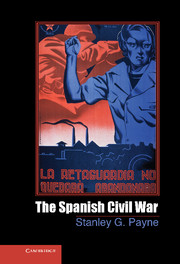Book contents
- Frontmatter
- Contents
- Chronology of Major Events
- Glossary
- Preface
- Introduction Civil War in Twentieth-Century Europe
- 1 Modernization and Conflict in Spain
- 2 From Revolutionary Insurrection to Popular Front
- 3 The Breakdown of Democracy
- 4 The Military Insurrection of the Eighteenth of July
- 5 The Battle of Madrid – the First Turning Point
- 6 Revolution
- 7 Terror
- 8 A War of Religion
- 9 Franco's Counterrevolution
- 10 Foreign Intervention and Nonintervention
- 11 Soviet Policy in Spain, 1936–1939
- 12 The Propaganda and Culture War
- 13 A Second Counterrevolution? The Power Struggle in the Republican Zone
- 14 The Decisive Northern Campaigns of 1937–1938
- 15 The War at Sea and in the Air
- 16 Civil Wars within a Civil War
- 17 The War in Perspective
- Conclusion Costs and Consequences
- Select Bibliography
- Index
- References
2 - From Revolutionary Insurrection to Popular Front
Published online by Cambridge University Press: 05 September 2012
- Frontmatter
- Contents
- Chronology of Major Events
- Glossary
- Preface
- Introduction Civil War in Twentieth-Century Europe
- 1 Modernization and Conflict in Spain
- 2 From Revolutionary Insurrection to Popular Front
- 3 The Breakdown of Democracy
- 4 The Military Insurrection of the Eighteenth of July
- 5 The Battle of Madrid – the First Turning Point
- 6 Revolution
- 7 Terror
- 8 A War of Religion
- 9 Franco's Counterrevolution
- 10 Foreign Intervention and Nonintervention
- 11 Soviet Policy in Spain, 1936–1939
- 12 The Propaganda and Culture War
- 13 A Second Counterrevolution? The Power Struggle in the Republican Zone
- 14 The Decisive Northern Campaigns of 1937–1938
- 15 The War at Sea and in the Air
- 16 Civil Wars within a Civil War
- 17 The War in Perspective
- Conclusion Costs and Consequences
- Select Bibliography
- Index
- References
Summary
The impact of the revolutionary insurrection was profound. In Asturias, the revolutionaries had seized control of most of a province, and a military campaign of more than two weeks was required to defeat them. From this point, polarization increased, and some historians have referred to the insurrection either as the “prelude to” or “first battle” of the eventual civil war. Nonetheless, the democratic Republic remained intact, and there was still opportunity to overcome, or at least palliate, the deepening polarization.
Almost all the new polities established in Europe after 1919 featured multiparty systems, but the Spanish Republic was unique in producing three successive drastic shifts in government within less than five years, making continuity very difficult and encouraging radicalization. Yet more unique was the absence of any coherent hegemonic force of the sort that, for good or ill, resolved crises in other countries. The Republic was unable to produce any kind of viable majority coalition, a dominant nationalist movement, a major hegemonic party, or even a temporary authoritarian government capable of enforcing its will.
For nearly a year, from October 1934 to September 1935, Spain was governed by a CEDA-Radical coalition. Whereas the initial biennium of 1931–33 had been a time of advanced, sometimes radical, reformism, the second phase under the Radicals in 1933–34 was a period of balanced administration from the center. The government that Lerroux led in the third phase from 1934 to 1935 was a center-right coalition that moved in a much more conservative direction, revising or canceling a number of the earlier reforms and abruptly reversing most of the limited agrarian reform. In one sense, this was a normal development in a representative political system in which different electoral results may lead to different policies, but according to the left, it was the beginning of “fascism.”
- Type
- Chapter
- Information
- The Spanish Civil War , pp. 24 - 36Publisher: Cambridge University PressPrint publication year: 2012



